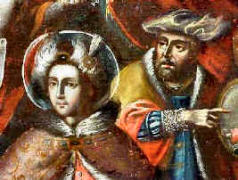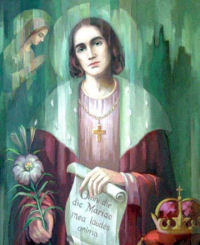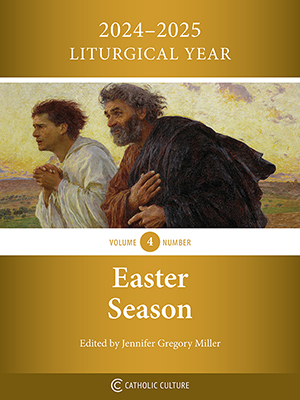Subscribe for free today!
Get newsletters with the latest content, and access to exclusive ebooks and podcast episodes.
Already subscribed? Log in to stop seeing invitations to subscribe.
Lent: March 4th
Monday of the Third Week of Lent; Optional Memorial of Saint Casimir
» Enjoy our Liturgical Seasons series of e-books!
The Liturgy today is concerned with Baptism. Water by itself cannot cleanse leprosy; but God can use it to do so. If God can cleanse the leprosy of the body with water there is no reason why he cannot use it to wash leprosy of soul. The second point which the Liturgy intends to bring home to us is that God’s salvation is offered and available to all men who believe in his words and obey them. —St. Andrew Bible Missal
Today is the Optional Memorial of St. Casimir (1458-1484) who was born in 1458 and was the son of the King of Poland. At an early age he saw through the superficiality and corruption of court life. Throughout his short life—he died of consumption at the age of 26—he dedicated himself wholly to the service of God and of his fellow-men. His love for the poor was immense. He was also renowned for his devotion to the Eucharist and to the Blessed Virgin.
Meditation—Baptized in Christ
Baptism is a key word in Lent. As we know, its institution was as a period of intense preparation for baptism at the Easter Vigil, and ideally it still has this slant. Baptism is never over and done with. Baptism is a state—it must always continue. We have been put into a state of Baptism and we must live out the truth of that state.
What does it mean to be baptized? Various answers will come to mind, but if the answers are authentic they will reflect different aspects of the basic truth. Baptism is ultimately the sacrament of the Fatherhood of God, by it we become His sons and daughters, which is what humanhood is all about.
How is this metamorphosis of becoming a child of God effected? By dying to our purely natural life and being born again into new life, spiritual life, the life of the Risen Christ which is the life of God Himself.
How is this metamorphosis of becoming a child of God effected? By dying to our purely natural life and being born again into new life, spiritual life, the life of the Risen Christ which is the life of God Himself.
Baptism takes us up into the movement of Jesus, “I go to the Father.” We know the incredible pain, grief, darkness of that journey which we call the passion and death of Jesus. Basically it is our journey through the sadness and darkness sin or estrangement from God has caused. It is because our only way to the Father lies through death that Jesus died. He transformed that dark passage. Now it is truly a pathway of light leading straight to the Father.
We are summoned to faith. Summoned to deny, move off our own base and to stand on God’s fidelity as revealed in Jesus. We are summoned to accept His judgements, His values, His point of view; to surrender to His will, His guidance. The opposite of sin is not virtue but faith. Faith destroys sin as light destroys darkness.
To be baptized, to live in the state of baptism is to live in and by faith: not just to make acts of faith now and then but to live our lives by faith—absolute trust in the forgiving, self-donating God.
What we tend to do is live faith in fits and starts, acknowledging Him in some areas, denying Him in others. Baptism only becomes total when faith is total. Then truly we have died with Christ to a purely human life, and risen to His divine way of being.
There can be no realism in our living unless we keep our eyes on the blessed passion of Christ, and Lent is the time when the Church bids us accept the pain of having this sacred passion always before our eyes. In the passion we measure the greatness of His love, the seriousness of our lives with their countless choices, the certitudes upon which we base ourselves.
Lent is the time of effort, warfare, discipline. Let us look and look again at the suffering Jesus and take the weight of shame and sorrow.
It is often said, and rightly, that we cannot contemplate the death and resurrection of Jesus save in the radiance of the resurrection. But because of what we are, there is a need that, at a particular time of year we should, as it were, step out of this radiance and stand in the unredeemed dark—looking at what our sins have done, looking at what our redemption cost the Lord.
“You who have been baptized in Christ are clothed head to foot in Christ.” Let us accept the shame of the necessary stripping so that we may indeed rise anew at Easter, clothed in the glory of the risen Jesus.
—Ruth Burrows, Through Him, With Him, In Him
St. Casimir
St. Casimir, to whom the Poles gave the title of "The Peace-maker," was the third of the thirteen children of Casimir IV, King of Poland, and of Elizabeth of Austria, daughter of the Emperor Albert II. ...Devout from his infancy, the boy gave himself up to devotion and penance, and had a horror of anything approaching softness or self-indulgence. His bed was often the ground, and he was wont to spend a great part of the night in prayer and meditation, chiefly on the passion of our Saviour. His clothes were plain, and under them he wore a hairshirt. Living always in the presence of God, he was invariably serene and cheerful, and pleasant to all. The saint's love of God showed itself in his love of the poor who are Christ's members, and for the relief of these the young prince gave all he possessed, using in their behalf the influence he had with his father and with his brother Ladislaus when he became king of Bohemia. In honour of the Blessed Virgin Mary, Casimir frequently recited the long Latin hymn "Omni die dic Mariae," a copy of which was by his desire buried with him. This hymn, part of which is familiar to us through Bittleston's version, "Daily, daily sing to Mary," is not uncommonly called the Hymn of St Casimir, but it was certainly not composed by him; it is three centuries older than his time.
 The nobles of Hungary, dissatisfied with their king, Matthias Corvinus, in 1471 begged the King of Poland to allow them to place his son Casimir on the throne. The saint, at that time not fifteen years old, was very unwilling to consent, but in obedience to his father he went to the frontier at the head of an army. There, hearing that Matthias had himself assembled a large body of troops, and finding that his own soldiers were deserting in large numbers because they could not get their pay, he decided upon the advice of his officers to return home. The knowledge that Pope Sixtus IV had sent an embassy to his father to deter him from the expedition made the young prince carry out his resolution with the firmer conviction that he was acting rightly. King Casimir, however, was greatly incensed at the failure of his ambitious projects and would not permit his son to return to Cracow, but relegated him to the castle of Dobzki. The young man obeyed and remained in confinement there for three months. Convinced of the injustice of the war upon which he had so nearly embarked, and determined to have no further part in these internecine conflicts which only facilitated the further progress into Europe of the Turks, St Casimir could never again be persuaded to take up arms though urged to do so by his father and invited once more by the disaffected Hungarian magnates. He returned to his studies and his prayers, though for a time he was viceroy in Poland during an absence of his father. An attempt was made to induce him to marry a daughter of the Emperor Frederick III, but he refused to relax the celibacy he had imposed on himself.
The nobles of Hungary, dissatisfied with their king, Matthias Corvinus, in 1471 begged the King of Poland to allow them to place his son Casimir on the throne. The saint, at that time not fifteen years old, was very unwilling to consent, but in obedience to his father he went to the frontier at the head of an army. There, hearing that Matthias had himself assembled a large body of troops, and finding that his own soldiers were deserting in large numbers because they could not get their pay, he decided upon the advice of his officers to return home. The knowledge that Pope Sixtus IV had sent an embassy to his father to deter him from the expedition made the young prince carry out his resolution with the firmer conviction that he was acting rightly. King Casimir, however, was greatly incensed at the failure of his ambitious projects and would not permit his son to return to Cracow, but relegated him to the castle of Dobzki. The young man obeyed and remained in confinement there for three months. Convinced of the injustice of the war upon which he had so nearly embarked, and determined to have no further part in these internecine conflicts which only facilitated the further progress into Europe of the Turks, St Casimir could never again be persuaded to take up arms though urged to do so by his father and invited once more by the disaffected Hungarian magnates. He returned to his studies and his prayers, though for a time he was viceroy in Poland during an absence of his father. An attempt was made to induce him to marry a daughter of the Emperor Frederick III, but he refused to relax the celibacy he had imposed on himself.
St Casimir's austerities did nothing to help the lung trouble from which he suffered, and he died at the age of twenty-six in 1484 and was buried at Vilna, where his relics still rest in the church of St Stanislaus. Miracles were reported at his tomb, and he was canonized in 1521.
—Excerpted from Butler's Lives of the Saints
Patronage: against plague; bachelors; kings; princes; single laymen; Lithuania (proclaimed by Pope Urban VIII in 1636); Lithuanian youth; Poland; diocese of Grodno, Belarus,
Symbols and Representation: Lily (for purity); crown; grand ducal cap
Highlights and Things to Do:
- St. Casimir died at age 26 due to tuberculosis. Teach the young people in your family about this saint who was so ready to die at such a young age, that they may realize that sanctity is fully attainable regardless of their state in life.
- Read more about St. Casimir:
- Casimir's remains lie in Vilnius Cathedral in Lithuania in a silver sarcophagus.
- See Catholic Cuisine for some food ideas for St. Casimir's feast day.
- See Domestic Church for some ideas on how to celebrate this saint at home.
- Don't be a Catholic who doesn't know Scripture! In the Gospel today there is a good Scripture verse to memorize that will deepen your trust in your Heavenly Father: "If you, with all your sins, know how to give your children what is good, how much more will your heavenly Father give good things to anyone who asks him!" —Matt 7:11

Monday of the Third Week of Lent
Station with San Marco al Campidoglio (St. Mark at the Capitol):
The Station is in the church of St. Mark, the full official name San Marco Evangelista in Campidoglio, St Mark the Evangelist at the Capitol, which was built in the fourth century in honor of the evangelist, by the holy Pope Mark, whose relics are kept there. This was the one of the oldest churches constructed. The church has undergone several reconstructions and restorations, including a heavy Baroque restoration.
For more on San Marco al Campidoglio, see:
For further information on the Station Churches, see The Stational Church.






